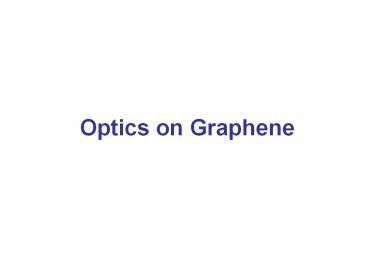Optics on Graphene PowerPoint PPT Presentation
Title: Optics on Graphene
1
Optics on Graphene
2
Gate-Variable Optical Transitions in
Graphene Feng Wang, Yuanbo Zhang, Chuanshan Tian,
Caglar Girit, Alex Zettl, Michael Crommie, and Y.
Ron Shen, Science 320, 206 (2008).
Direct Observation of a Widely Tunable Bandgap in
Bilayer Graphene Yuanbo Zhang, Tsung-Ta Tang,
Caglar Girit1, Zhao Hao, Michael C. Martin, Alex
Zettl1, Michael F. Crommie, Y. Ron Shen and Feng
Wang (2009)
3
Graphene(A Monolayer of Graphite)
2D Hexagonal lattice
4
Properties of Graphene
Electrically High mobility at room
temperature, Large current carrying
capability Mechanically Large Youngs
modulus. Thermally High thermal
conductance.
5
Exotic Behaviors
Quantum Hall effect, Barry Phase Ballistic
transport, Klein paradox Others
6
Quantum Hall Effect
Y. Zhang et al, Nature 438, 201(2005)
7
Optical Studies of Graphene
Optical microscopy contrast Raman
spectroscopy Landau level spectroscopy.
8
Crystalline Structure of Graphite
9
Graphene
2D Hexagonal lattice
10
Band Structure of Graphene Monolayer
P.R.Wallace, Phys.Rev.71,622-634(1947)
11
Band Structure of Monolayer Graphere
12
p-Electron Bands of Graphene Monolayer
13
Band Structure in Extended BZ
14
Band Structure near K Points
10 eV
15
Band Structures of Graphene Monolayer and Bilayer
near K
Bilayer
Monolayer
x
K
K
x
Vertical optical transition
Van Hove Singularity
EF is adjustable
16
Exfoliated Graphene Monolayers and Bilayers
Reflecting microscope images.
20 ?m
Monolayer
Bilayer
K. S. Novoselov et al., Science 306, 666 (2004).
17
Raman Spectroscopy of Graphene
(Allowing ID of monolayer and bilayer)
A.S.Ferrari, et al, PRL 97, 187401 (2006)
18
Reflection Spectroscopy on Graphene
19
Experimental Arrangement
Det
OPA
Graphene
Gold
290-nm Silica
Doped Si
20
Infrared Reflection Spectroscopyto Deduce
Absorption Spectrum
Differential reflection spectroscopy Difference
between bare substrate and graphene on substrate
RA bare substrate reflectivity RB substrate
graphene reflectivity
A
20 ?m
B
-dR/R ? (RA-RB)/RA versus w
dR/R -Reh(w)s(w)
h(w) from substrate s(w) from graphene
interband transitons free carrier
absorption
Re s(w)/w Absorption spectrum
21
Spectroscopy on Monolayer Graphene
22
Monolayer Spectrum
x
C capacitance
23
Experimental Arrangement
Det
OPA
Graphene
Gold
290-nm Silica
Vg
Doped Si
24
Gate Effect on Monolayer Graphene
X
X
X
Small density of states close to Dirac point E
0 Carrier injection by applying gate voltage can
lead to large Fermi energy shift .
EF can be shifted by 0.5 eV with Vg 50 v
Shifting threshold of transitions by 1 eV
If Vg Vg0 Vmod, then
should be a maximum at
25
Vary Optical Transitions by Gating
Vary gate voltage Vg.
Laser beam
Measure modulated reflectivity due to Vmod at V
( Analogous to dI/dV measurement in transport)
26
Results in Graphene Monolayer
The maximum determines Vg for the given EF.
27
Mapping Band Structure near K
For different w, the gate voltage Vg determined
from maximum is different, following
the relation ,
Slope of the line allows deduction of slope of
the band structure (Dirac cone) ??
28
2D Plot of Monolayer Spectrum
Experiment
Theory
29
Strength of Gate Modulation
Vg 0
D(dR/R) ? (dR/R) 60V -(dR/R) -50V
30
Bilayer Graphene(Gate-Tunable Bandgap)
31
Band Structure of Graphene Bilayer
For symmetric layers, D 0 For asymmetric layer,
D ? 0
E. McCann, V.I.Falko, PRL 96, 086805 (2006)
32
Doubly Gated Bilayer
Asymmetry D ? D ? (Db Dt)/2 ? 0 Carrier
injection to shift EF ??F ? dD ?(Db - Dt)
33
Sample Preparation
Effective initial bias due to impurity doping
34
Transport Measurement
Maximum resistance appears at EF 0
Lowest peak resistance corresponds to Db Dt 0
?? .
35
Optical Transitions in Bilayer
I Direct gap transition (tunable, lt250
meV) II, IV Transition between
conduction/valence bands (400 meV, dominated by
van Hove singularity) III, V Transition
between conduction and valence bands (400 meV,
relatively weak) If dEF0, then II and IV do not
contribute
36
Bandstructure Change Induced by
x
IV
x
II
Transitions II IV inactive Transition I active
37
Differential Bilayer Spectra (dD 0)(Difference
between spectra of D?0 and D0)
I
I
IV
Larger bandgap ? stronger transition I because
ot higher density of states
38
(No Transcript)
39
Charge Injection without Change of Bandstructure
(D fixed)
dD ?0
dD 0
x
IV
III
Transition IV becomes active Peak shifts to
lower energy as D increases.. Transition III
becomes weaker and shifts to higher energy as D
increases.
40
Difference Spectra for Different D between
dD0.15 v/nm and dD0
41
Larger D
42
Bandgap versus D
43
Strength of Gate Modulation
D(dR/R) ? (dR/R) 60V -(dR/R) -50V
is comparable to dR/R in value
44
Summary
- Grahpene exhibits interesting optical behaviors.
- Gate bias can significantly modify optical
transitions over a broad spectral range. - Single gate bias shifts the Fermi level of
monolayer graphene. - Spectra provides information on bandstructure,
allowing deduction of VF (slope of the Dirac
cone in the bandstructure). - Double gate bias tunes the bandgap and shifts
the Fermi level of bilayer - graphene.
- Widely gate-tunable bandgap of bilayer graphene
could be useful in future device applications. - Strong gating effects on optical properties of
graphene could be useful in infrared
optoelectronic devices.
45
(No Transcript)

